JARS v62n3 - Northwest Yunnan: Dream to Reality
Northwest Yunnan: Dream to Reality
Jennifer Velinty
Florence, Oregon
The Rhododendron species of Northwest Yunnan, in China, thrive at about 30º latitude and in a wide range of altitudes. For example, Rhododendron augustinii ssp. chasmanthum grows between 4,500-13,000ft, and R. anthopogon prefers a cooler range of 9,000-16,500ft (Greer, 1996).
The soils in Northwest Yunnan are mostly compounded from weathered limestone rocks that often vary in color according to the mineral content prevalent in different areas. Rhododendrons in Yunnan seem to grow well in soils with iron, magnesium and calcium content, particularly when supplemented with ample leaf and pine duff. Moisture is provided by annual rains, low clouds and snow melt, and the annual temperatures from the lower elevations to alpine heights can range from –20ºF to +90ºF. Rhododendrons were found in varied habitat: R. yunnanense and R. decorum were associated with pines and tall shrubs and R. hippophaeoides was found in exposed, sometimes boggy areas.
In contrast, my small garden on the Oregon coast is at 45º latitude and 84ft altitude. The annual rains provide about 85 inches of moisture and temperatures can range from an occasional 10ºF to 99ºF. But gusty winds and browsing deer are the usual hazards.
Under these conditions I can grow propagated Rhododendron species, planted in fir bark over sandy soils with moderate success, and by incorporating the Oregon coast native evergreen plants of R. macrophyllum , conifers and flowering shrubs the garden has a woodland setting.
Receiving the American Rhododendron Society journals with photographs of the rhododendrons of Yunnan and the Tibetan Plateau inspired me to see some of the genus in its native habitat. Fortunately for me, a tour from Australia to Northwest Yunnan led by experienced botanists gave me the chance to ask Diane Weissman 1 to handle myriad travel details and I was able to experience the greatest trip of a lifetime.
Ben Wallace 2 met me at Kunming airport and I joined seven Australians for a 20-day tour of Northwest Yunnan and the Tibetan Plateau. Designed by Ben and Xiaomei 3 Wallace, the meticulously planned itinerary, with 4-star hotels and travel with experienced guides and a talented driver, described a cultural and botanical tour of ancient cultures, unique species of plants and spectacular scenery.
Kunming was warm at the end of May 2007 with street trees of planes and maples shading crowds of people riding bicycles and small motorbikes. From the bus I could see bicyclists with small children riding in colorful backpack baskets, and a slim couple riding on a scooter had a child seated between them. Many women swept the streets with long-brushed brooms as pedestrians grouped together to cross ten lanes of traffic. A few brave individuals dodged between cars, buses and bikes. My gaze was attracted to raised planters of multicolored potted begonias, pansies and marigolds set out in small pots that were packed tightly together in creative expanses of floral displays.
Near the city of Kunming are popular attractions such as the World Horticultural Expo 99 with displays of Chinese gardens, a butterfly enclosure and award-winning porcelain and jade. There were many examples of regional and international gardens and many trial gardens growing new varieties of vegetables, fruit, tea and different types of fungi. In another part of the gardens, the bronze Golden Temple dating from the Qing dynasty sits high on a hilltop surrounded by Botanical Gardens with old plants of Camellia , Lagerstroemia indica , Cryptomeria japonica ssp. sinensis and mixed natural stands of Keteleeria evelyniana and Quercus variabilis . Further from the city we saw the remarkable Stone Forest, with pathways and stairs winding through gardens and over ponds set between towering gray limestone formations. Our guide was resplendent in her intricate ethnic clothing and took us to see long lines of women in regional clothing dancing to traditional live music of the ethnic people.
We visited the Western Hills National Park overlooking Lake Dianchi and rode in a cable car above forests of regenerating conifers up to the Hua Ting and Tai Hua Buddhist monasteries with buildings housing golden Buddhas and offerings. Statues at the entrance represented four needs of the Chinese, and depicted Food, Health, Family and Protection. Traditional classic half-couplet poems were painted in Chinese characters on each side of the entrance, in the scholarly style of earlier centuries. Peaceful green gardens of Gingko biloba trees included a huge 600-year-old tree fully leafed out and Magnolia grandiflora in full bloom surrounded by mixed forests of Pinus armandii , P. yunnanensis and P. densata , Cupressus duclouxiana and Keteleeria evelyniana . Fragrant lotus was still waiting to flower in ponds that were now glowing with pink water lilies and full of orange fish and dozens of little turtles clustered on flat rocks. All were symbols representing a long and healthy life.
The tour itinerary started in Kunming elevation 6,000ft, continued to Dali and Lijiang at 6,500ft, and on to Lake Lugu situated at 10,000ft, Zhongdian (Shangrila) at 11,500ft and up mountain roads to cross over 13,500ft passes to Deqin at almost 14,000ft. Heading first to Dali, we followed part of the old Silk Road, one of the original arteries of trade from the ancient city of Xi-an that extended west as far as the eastern Mediterranean. We traveled on a new express toll-way that divided a warm valley of agriculture. Groves of ripening banana plants and red flowered pomegranate trees bordered well-kept farms of taro and rice paddies, ploughed with water buffaloes, and workers cultivating rows with long handled hand tools. Farmers sold produce from tables loaded with mushrooms, black fungi, and many kinds of fruits and vegetables. Baskets of spices, sacks of nuts and grains made a colorful display. One vendor handfed young blackbirds for sale as pets.
Along the way we read National Geographic articles of 1926 and 1930 by botanist Joseph Rock, who mapped Northwest Yunnan and collected hundreds of plant and animal specimens. Dr. Rock explored the gorge of the Dulong river in western Yunnan and traveled east to search out and map the Salween (Nu Jiang), Mekong (Lancang Jiang) and Yangtse gorges. Tribesmen and horses carried his equipment across mountains and all of them had to traverse glacial rivers on twisted vine ropes. Dr. Rock rested at monasteries where he had protection to develop photographs and could give medical care to the local people, and in later years he retired to the Yu Zhu Qing Tian (Jade pillar to the sky) monastery that keeps some of his books, faded photographs and simple furnishings. In the monastery gardens, an enormous Magnolia grandiflora shaded the courtyard and ancient entwined camellias grew near a patio that was paved with small stones, individually set in place in traditional designs.
Driving on we saw stands of blue gum Eucalyptus globulus had been topped, limbed and extensively pruned to force new growth and harvest the pungent oils for pharmaceutical use. We stopped to hunt for wildflowers in arid, stony fields finding many tiny species surviving and blooming.
In Dali we went to a community market selling huge sides of dry meats, piles of fresh fruits, vegetables, spices and fungus. There were buckets of live fish and eels and big bowls with blocks of creamy bean curd tofu. We saw the huge cooking pans, farming hardware and all the equipment needed by an agrarian society. All of the old ways were juxtaposed with high-rise construction that is impacting populations in cities, on farms and in natural habitats.
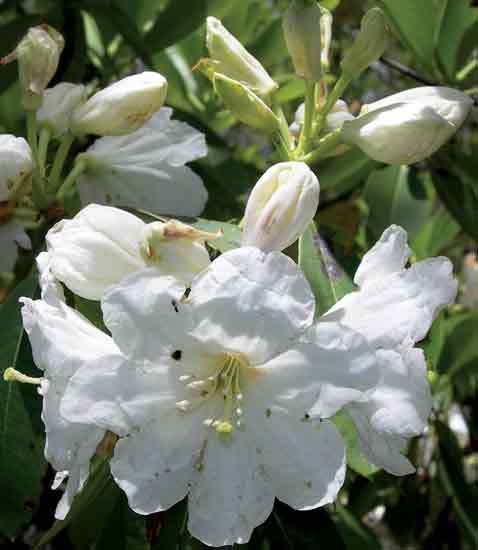
|
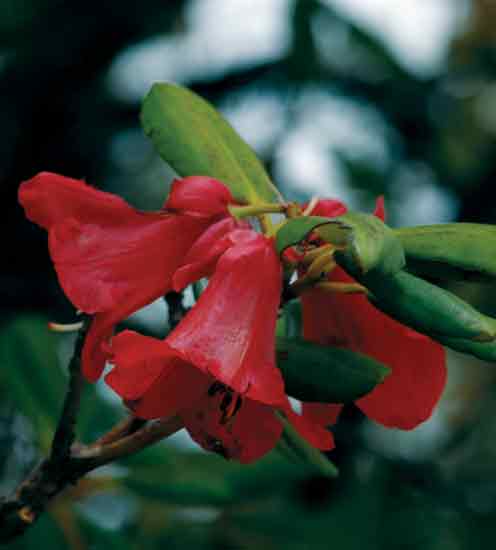
|
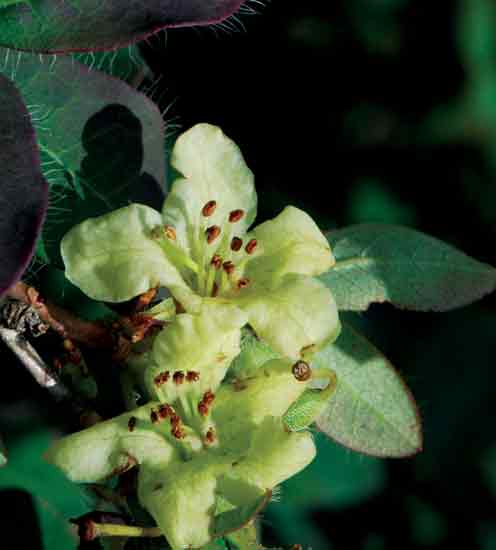
|
||
|
R. decorum
Photo by Ian Chalk |
R. neriiflorum
Photo by Ben Wallace |
R. mekongense
on Cang Shan.
Photo by Ben Wallace |
We spent almost a day on the Cang Shan, between 7,000 and 10,000ft, for our first plant hunting expedition. Driving up a dirt road to reach the Cang Shan, near Dali, we found many recognizable plants in a mixed forest of oaks and genera Lithocarpus and Castanopsis . We saw Hypericum , Deutzia , Indigofera , Mahonia , and Gaultheria . Further along we saw familiar Buddleja fellowiana , Pieris , Syringa , Viburnum and Sorbus and white Clematis montana blooming high in a tree. The creamy white funnels of Rhododendron maddenii reached above green shrubs. Several taller lavender-pink R. microphyton were competing with shrubs for sunlight and space. Hiking up Cang Shan we looked for white R. decorum , creamy R. pachypodum , and saw red R. neriiflorum blooming. The climb was steep from 8,000 to 10,500ft hunting for the 27 species of rhododendrons found on Cang Shan. At 9,000ft, plants of R. virgatum , R. simsii , and R. leptothrium were seen. Smaller plants of R. microphyton , R. mekongense var. rubrolineatum , and R. racemosum were growing at 9,500ft, and at 12,000ft R. taliense and R. balfouriaum could be found. Heading up to see conifers of blue-coned Abies delavayi and Rhododendron lacteum I looked for the red flowers of R. facetum and the puckered leaves of R. edgeworthii and found the soft oval reddish leaves of the partially evergreen azalea R. simsii . Hearing shouts and tinkling bells, I stepped off the steep trail for a string of six packhorses, carrying supplies for a powerline across China. From Beijing to Lhasa, new roads, railways and power lines have connected cities, villages and farms to each other and the world.
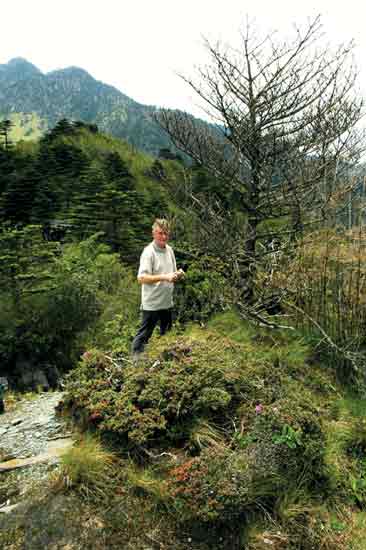
|

|
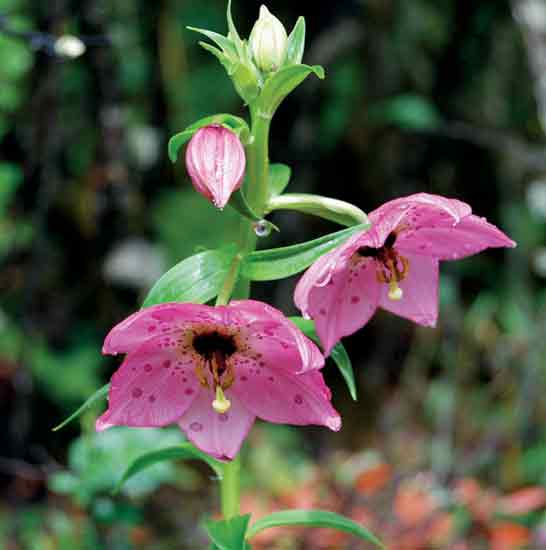
|
||
|
Barry Davidson and
R. impeditum
on Cang Shan.
Photo by Ben Wallace |
R. impeditum
on Cang Shan.
Photo by Ben Wallace |
Nomocharis forrestii
Photo by Ian Chalk |
Education is a high priority to prepare children for the new business economy. Many children in cities attend school six days a week when parents work. Rural children attend school, take care of animals and gather pine duff for fuel and grasses for animal feed. As farms push higher into the hills, agriculture and grazing co-mingle with precious botanical sites. On Cang Shan, wild flowers of lilies and orchids bloomed near a waterfall and plants of Ranunculus , Anemone and Primula thrived in ditches along the road.
That evening we walked in old Dali's cobbled streets and visited small shops with open fronts selling everything from tea, spices and produce to herbal mixtures for Chinese medicine. Wooden buildings had upturned tile roofs with sharp corners that are designed to deter any hovering demons from entering the building.
On the way to Lijiang we saw work by Bai artisans and craftspeople. The local green marble was carved into decorative screens and beautiful translucent bowls. We reached Zhoucheng, near Dali, and watched women preparing cloth for tie-dyed items. Design details were picked up with needle-and-thread, tied tightly, dyed a deep indigo, and sun dried. Knots were untied to reveal traditional Bai patterns.
Later that day we arrived in Lijiang, a trading center since the thirteenth century that lies below the snowcapped mountain range of Yulong Shan, Jade Dragon Mountain, and is a World Heritage site on the old Silk Road. The ethnic Naxi are known to appreciate Chinese music and poetry dating to the seventh century. In times of cultural chaos the Naxi buried instruments, music, and paintings, saving a heritage of songs and art for peaceful times. We were privileged to visit an old, colorfully painted theater to hear the only World Heritage Orchestra of senior musicians sing and play ancient music on flutes, pipes, bells, gongs and strings. Near the theater we climbed up steps to photograph a 600-year-old Cupressus funebris that was a revered landmark perched on a high viewpoint.
Traveling on to Lake Lugu we visited a plant reserve high in the hills with a paved viewing area overlooking the lake. Among gardens of native plants and transplanted species rhododendrons, a pale pink Rhododendron trichostomum bloomed under a pine canopy.
Along the road the dry limestone slope held many botanical treasures of tiny wildflowers of Primula , Iris , Gentiana , and Anemone , also Saxifraga , Persecaria and Potentilla . We were surrounded by pink, purple, yellow and white flowers, and little leaves of Androsace sheltering between stones. Higher up on the road to Lake Lugu a tall, pink Rhododendron decorum on the side of a hill had everyone scrambling to take photographs.
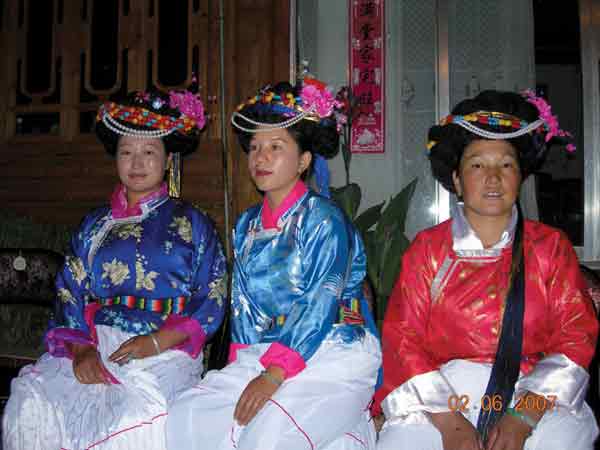
|
|
Mosuo women at Lake Lugu.
Photo by Ian Chalk |
Lake Lugu, edged with forests, is homeland to the Mosuo people, a matrilineal society who have no word for marriage. Women have control of the children and all the property. The matrilineal society was hounded by authorities with accusations of promiscuity. The women were pressured to be monogamous, disrupting the people's ethnic traditional values for almost twenty years. Now the traditional way of life has been restored with some compromises. Near Zhongdian, we were invited into a colorful Tibetan family home and farm that belonged to the oldest woman in the extended family and would go to the next oldest. The custom derives from times of war when women raised families and maintained farms and livestock for the next generation. A new grandbaby wore a reflective round patch on his forehead to keep away any evil.
On the shore of Lake Lugu were wooden buildings with many shops shaded by trees. The next day we crossed the lake in long narrow rowboats to an island with three Buddhist temples settled into forests thick with shrubs, rhododendrons and wild flowers. Riding across the calm lake the tranquility was enhanced by a Mosuo woman singing a traditional song. On the island, R. arboreum ssp. delavayi bloomed, and we found the slender leaves of a white flowered R. vernicosum and lavender R. rubiginosum . Growing nearby, a tall pink flowering shrub was hanging over the lake and contrasted against a bright blue sky. Stepping over tiny blue irises, yellow anemones and pink primulas, I climbed to the pavilion of the highest temple. Marble floors were littered with paper patterns and piles of fragrant wood were thick with sawdust. Young craftsmen used hand tools to carve out flowers and birds to decorate the wooden screens that would form the walls of the building. Brightly painted ceilings and carved screens were seen in every temple. One screen depicted a revered monk walking through forests, unhurt by animals, bandits or stormy weather.
That evening we attended a village performance of Mosuo dances beginning at dusk with a huge bonfire. Women in bright traditional dress held hands to circle the courtyard around a huge bonfire and the flutist played faster when energetic young men joined the dance.
On the journey to Zhongdian on the Tibetan Plateau we crossed the great Yangtse River and descended 900 steps into the deep gorge called Tiger Leaping Gorge, named for a mythical tiger that leaps the Yangtse by stepping on a midstream boulder. Looking down 12,500ft between the summits of Jade Dragon and Haba Shan, the churning river is pinched between towering rock walls as it gouges around a huge boulder. The mountain roads were built of hand-fashioned rocks fitted tightly together. They cut around hillsides of crumbling limestone, keeping workers busy shoveling away rockslides. Driving through forests of tall conifers, we came to steep areas of logged hills where wild rose bushes bloomed in the sun. Pine trees sheltered small plants of R. yunnanense in lavenders and pink, all growing in dry orange-yellow limestone and pine-duff. Pollinated by butterflies, insects, and even small birds, the self-seeding plants had spread downhill in rainwater runoffs. Small trees of Cornus macrophylla and Clematis montana were in full bloom and we scrambled up to see acres of pink and purple flowers of Rhododendron hippophaeoides and R. rubiginosum blooming under pine trees.
Traveling up a tributary river gorge of the Chong Jiang to Zhongdian and the Tibetan Plateau, we drove through mixed forests of broadleafs and conifers. Frequent stops for brilliant pink Primula poissonii , yellow Euphorbia nematocypha , white Anemone trullifolia and many wild flowers, strained our camera batteries and card capacity. We were recharged after great meal of freshly prepared regional food washed down with Tibetan beer or green tea and a few brave folks tried the Tibetan "firewater" drink.
The next morning we visited the Songzanlin Tibetan Buddhist lamasery destroyed by the Red Guards in an upheaval of Tibetan life and culture. For the last twenty years worldwide support has provided 80 percent of the funding to rebuild the lamasery, a major regional Buddhist center and home to over 700 monks living in clustered homes at the base of the huge building. The temple roof shined gold at the top of the hill as we walked up passing tall wooden drying racks for crops and a wetland where young monks washed red robes. I was told the monks once used ox blood to dye their garments. By devoting their lives to prayer and meditation they aspire to reach enlightenment and promote peace after decades of turmoil and destruction.
A white stucco building with upturned roof corners was a Tibetan hotel. The black window frames were wider at the base, in a design I saw only in Tibet. I was told they reflected the shape of mountains which are sacred to Tibetans. Inside the hotel were colorful traditional designs, with lacquer paintings on furniture, colorful woven wool wall hangings, and incised designs on brass stair treads.
Driving up to the Nappa Hai wetland and bird habitat, an important over-winter refuge for storks and wading birds, we spent a few hours at the Alpine Botanic Gardens and Cypripedium Reserve. The area had a mixture of small Yunnan pines, dwarf evergreen oaks with prickly leaves, maple, poplar and birch trees stretching to the top of the hill. Four different cypripediums grew in sheltered clusters with edelweiss, irises and primulas. The orchids in colors of reddish brown, yellow, shocking pink and white were resplendent with striped saccate lips and long twisting laterals. The efforts of orchid lovers established the reserve to protect these stunning plants. In tall, thick shrubbery at the top of the hill we found a few plants of Rhododendron decorum and R. vernicosum , and lavender-purple R. hippophaeoides growing on open ground.
We entered the largest national park in China, the sub-alpine Lake Shudu, and walked near a meadow with grazing black Dzu's, a cross between yaks and cows that can tolerate altitudes under 14,000ft. Full-bodied yaks prefer the highest meadows and cooler weather. Surrounded by thick mixed forests, new boardwalks hugged the lake winding through trees, shrubs, bog-loving yellow Rheum alexandrae and a huge tree of lavender Rhododendron yunnanense hanging over the lake. At a picnic area two tiny girls in traditional dress posed with small white goats for tourists' photos. Passing through villages of the ethnic Yi people, we saw traditional black headdresses worn by older women, some with facial tattoos that were reminders of tribal raiders who spurned girls with tattoos and did not abduct them. We saw the rural women carrying huge loads of wood or selling bananas from a bicycle and men pushing carts of charcoal bricks, recycled products or selling produce along the road. Along the side of the road near a ploughed field, a drainage ditch held a colony of yellow candelabra Primula bulleyana and further along was a hillside covered with yellow Meconopsis integrifolia with 4-inch flowers. In a little valley we saw a reminder of the Sequoia sempervirens of California. A small grove of tall Cupressus gigantea grew on steep slopes above the river. A temple garlanded with fluttering prayer flags and a 10ft high prayer wheel, was a sacred place that honored a huge and revered tree said to be 800 years old.
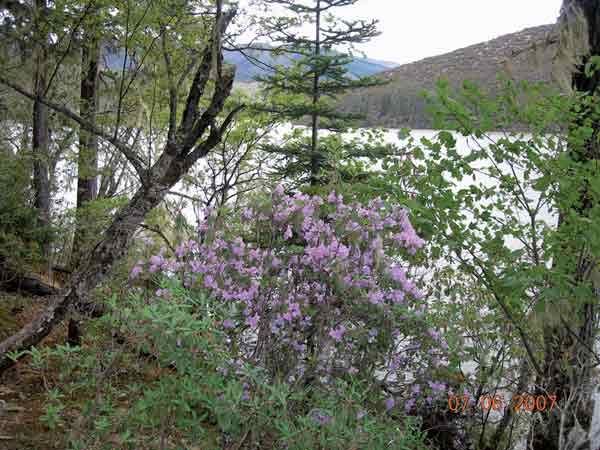
|
|
R. yunnanense
tree over Lake Shudu.
Photo by Ian Chalk |
The weather was refreshingly cool and misty in the mountains when we stopped to photograph a golden yellow Rhododendron wardii and the snow capped mountain ranges with glaciers. We were able to walk up to view the moraine and toe of the Ming Yong Glacier that drained to the Mekong Gorge from the Kabadkapo Snowy mountain range. The wide glacier descended in five stages from collection to joined, crevasse, moraine and toe. It passed by a Buddhist temple and forests of Pseudotsuga forrestii , Picea brachytyla , oaks, poplars, flowering shrubs and wildflowers. In a high pass near Deqin deciduous larch Larix potaninii became more prevalent among groundcover of purple Rhododendron russatum and R. rupicola , and taller shrubs of R. beesianum . We stopped for a patch of pink-purple primula, Primula sinopurpurea , finding wet spots with Primula secundifilora , with pink umbellate heads, near a slope of yellow Paeonia . Around the next corner was a vision of pale lavender. It was hard to believe I was walking in hillsides covered with tall Rhododendron yunnanense with a scenic backdrop of the world's highest unclimbed mountain, Mt Mei Li at over 21,000ft. From our hotel in Deqin we watched clouds and smoke from pine-branch offerings obscure the mountain, and as we waited for that early morning perfect photo-op the high peak glowed in the early sunlight.
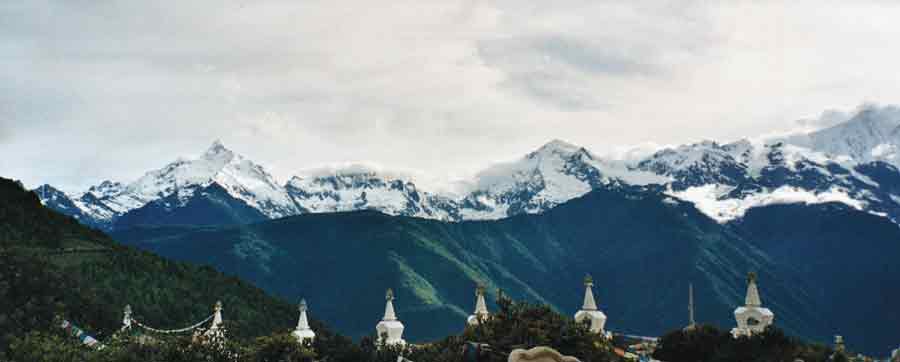
|
|
Mt. Mei Li mountain range at 21,000 ft from Deqin, sacred to Tibetans, prayer flags
and altars burning pine offerings.
Photo by Jennifer Velinty |
A day at Lake Bigu, a sub-alpine glacial relic, was another highpoint of the tour. Near a Tibetan summer camp at 13,500ft small black pigs rooted between clumps of heavy headed pink primula and around stacked piles of yak dung collected and dried for fuel. Abundant wildflowers clustered on the roadside bank with Meconopsis integrifolia , maroon Cypripedium tibeticum , Corydalis , pale Fritillaria , Lilium and Cassiope . Near trees of Abies and Picea , acres of purple heath of Rhododendron hippophaeoides , R. impeditum , R. tapetiforme , tall white R. aganniphum and pink R. phaeochrysum were all blooming together. It was truly a dream come true to be walking through acres of Rhododendron species on an alpine hillside.
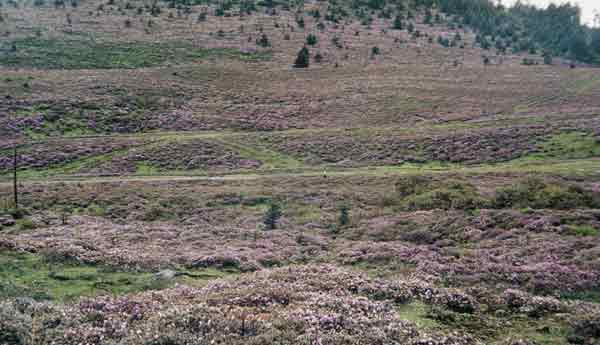
|
|
Alpine mountainside of rhododendron heath.
Photo by Jennifer Velinty |
Acknowledgements
For travel, photograph contributions and botanical information, I am indebted to my travel companions and the following people who generously shared knowledge and experience:
1 Diane Weissman is a private client travel agent, Mountain View, CA.
2 Dr Ben Wallace is a retired Horticultural Botanist of the Royal Botanical Gardens Sydney and Director of Living Collections at the Australian National Botanic Gardens in Canberra.
3 Xiaomei Wallace is a linguist in Mandarin, Cantonese and English and has a background in plant science and gene technology.
Ian Chalk from Tasmania, photographer and mountain trekker.
Harold E Greer, Eugene, OR, Greer's Guidebook to Available Rhododendrons, third edition , 1996.
Jenny Velinty is a member of the Siuslaw Chapter in Florence, OR, and has traveled to the UK, Ireland, Europe, Australia and New Zealand to see rhododendron gardens. This trip to Northwest Yunnan and the Tibetan Plateau was the greatest trip of a lifetime.
